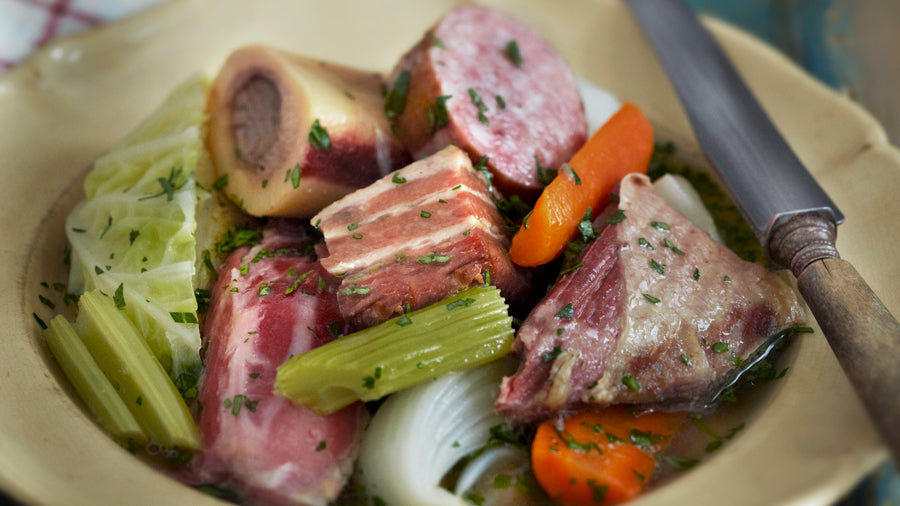A whole better way to eat

Eating more of the whole animal does everybody good.
It’s not a new idea. Fact is, humans have been eating meat for roughly 2.6 million years. In fact, the guys who really know about this stuff say it was probably eating meat that triggered the Australopithecus brain (our short and stocky apelike ancestors) to evolve into the Homo sapien brain (our early modern human ancestors). Wonderful to think a nice juicy mammoth steak helped increase the early human brain size by 300 percent.
So, we know eating meat matters. But what you may not know is eating more of the whole animal is nutritionally important, too. Our hunter-gatherers-ancestors didn’t just eat muscle meat —organ meat (sometimes called Offal), was highly prized, too. Hardly surprising when you consider organ meat is some of the most nutrient-dense food on the planet.
Meat: the super food
Organ meats ——like liver, kidney, heart, giblets, and more — are excellent sources of protein and minerals (iron, calcium, sodium, potassium, magnesium, selenium and zinc).
For example, just one ounce of beef liver has:
Protein 5.48 g
Carbohydrate, by difference 0.967 g
Calcium, Ca 1.14 mg
Iron, Fe 1.23 mg
Magnesium, Mg 3.99 mg
Phosphorus, P 93.7 mg
Potassium, K 66.3 mg
Sodium, Na 76.2 mg
Zinc, Zn 0.999 mg
Copper, Cu 2.69 mg
Selenium, Se 6.8 μg
Vitamin C, total ascorbic acid 0.361 mg
Thiamin 0.036 mg
Riboflavin 0.645 mg
Niacin 3.3 mg
Vitamin B-6 0.192 mg
Folate, total 47.7 μg
Folate, food 47.7 μg
Folate, DFE 47.7 μg
Choline, total 80.3 mg
Vitamin B-12 13.3 μg
Vitamin A, RAE 1780 μg
Retinol 1780 μg
Carotene, beta 30.6 μg
Carotene, alpha 2.09 μg
Cryptoxanthin, beta 2.09 μg
Vitamin E (alpha-tocopherol) 0.097 mg
Vitamin D (D2 + D3) 0.228 μg
Vitamin K (phylloquinone) 0.627 μg
And 1 oz of heart meat— chicken, beef, pork or lamb has all this goodness:
Protein 28.24 g
Carbohydrate, by difference 0.15 g
Calcium, Ca 5 mg
Iron, Fe 6.33 mg
Magnesium, Mg 21 mg
Phosphorus, P 252 mg
Potassium, K 217 mg
Sodium, Na 381 mg
Zinc, Zn 2.85 mg
Copper, Cu 0.554 mg
Selenium, Se 38.6 μg
Thiamin 0.1 mg
Riboflavin 1.2 mg
Niacin 6.624 mg
Vitamin B-6 0.243 mg
Folate, total 5 μg
Folate, food 5 μg
Folate, DFE 5 μg
Choline, total 226.9 mg
Vitamin B-12 10.71 μg
Vitamin E (alpha-tocopherol) 0.29 mg
Vitamin E, added 0 mg
Vitamin D (D2 + D3) 0.1 μg
Vitamin K (phylloquinone) 0.5 μg
Plus heart meat is also the richest source of naturally occurring coenzyme Q10 (CoQ10) which supports heart health, blood pressure health and is a nutritional powerhouse for mitochondria.
Animal protein in general provides all nine essential amino acids that your body needs to function effectively. And don’t forget the bone marrow — while not an organ—the many benefits of bone marrow (rich in collagen and glucosamine) include reduced inflammation with a boost in tissue repair.
Mother knows best
Not all organ meat is created equal. At Grass Roots our organ meat and giblets come from animals living just as mother nature intended: pasture-raised, grass-fed, hormone, pesticide and GMO free pastures.
That’s because we believe in the very best quality of life for all the animals our farmers raise. Imagine: pigs, cows, turkeys, chickens, and sheep grazing or foraging in the natural conditions they’ve evolved to thrive in. And you know what, that makes all our meats taste different. Better. So, whether you order prime rib or chicken livers it’s all going to taste incredible.
Time to go whole-hog
Some of the world’s greatest chefs are doing just that— cutting back on food waste by finding new and innovative ways to use more of the whole animal in their culinary creations. As Michelin-starred chef and author Fergus Henderson says, "It would be disingenuous to the animal not to make the most of the whole beast; there is a set of delights, textural and flavorsome, which lie beyond the fillet." And Henderson is not alone in his quest to cook “Nose to Tail”. Conscientious and resourceful chefs like Gordon Ramsay, Magnus Nilsson, Jamie Oliver, Daniel Boulud, Tom Kerridge — to name a few —all advocate using everything edible from the animal to create spectacular dishes.
Of course, you don’t have to be an award-winning chef to cook more of the animal. Ask about a family recipe. Chances are, your grandma knew all about turning giblets into amazing soups, stuffing and gravy. Try a simple and tasty Chinese beef liver stir fry. Kidneys aren’t just for steak pies — they can be used to add bold flavor to stews, chilly, meatloaf, and more. Start by searching offal recipes online. Then order right here.
You’ll find all the best nature has to offer, all flavorful. And when you eat a variety of meat cuts and grass-fed beef offal, you’re doing what’s best for you, for the animal, for the farmer and for the planet. You can’t do better than that.
----------------------------------------------------------------------------------------------
1 All nutritional facts for Organ meat can be found on the USDA U.S. DEPARTMENT OF AGRICULTURE Agriculture Research Services web site under organ meats https://fdc.nal.usda.gov/fdc-app.html#/?query=organ%20meats



